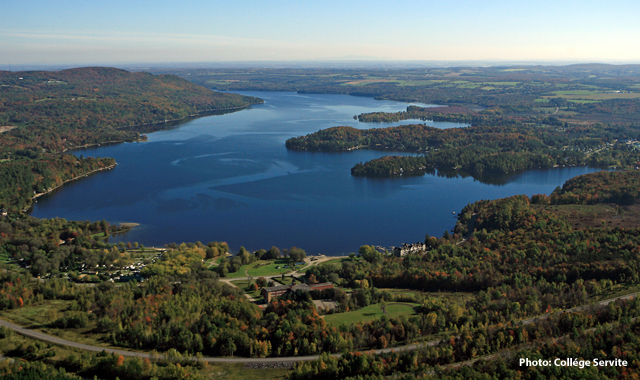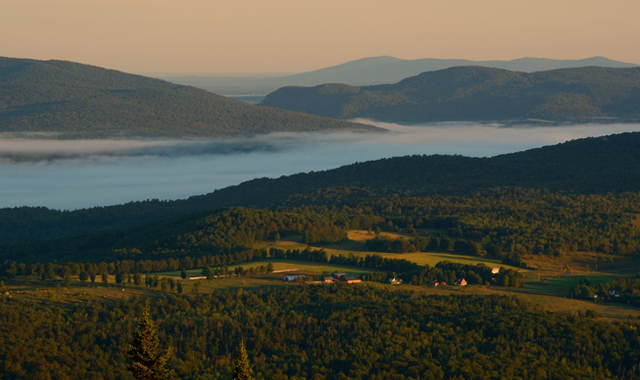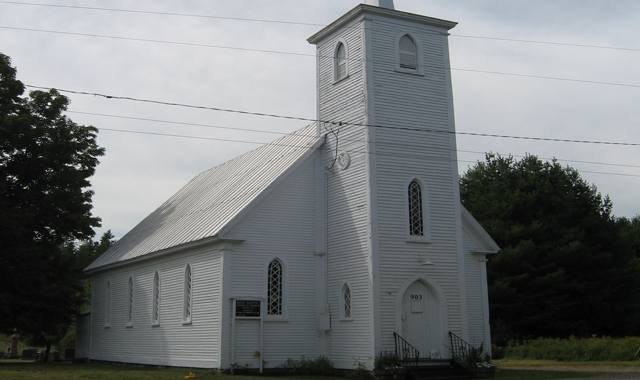Région de Memphrémagog
The Memphremagog regional municipal county is a magnificent region with a wealth of majestic mountains and lakes. In the late 18th century, mostly American but also English settlers founded many of the hamlets that have today become towns and villages. Beginning in 1840, French Canadians started settling in the region as well, leaving behind the overcrowded seigneurial concessions along the Saint Lawrence River to “open” new lands. Irish immigrants also became part of this population movement, particularly in the Magog area. The wood industry was one of the first economic engines, but served almost exclusively as a domestic resource. In the 19th century already, roads led the Americans to their second residences, guest houses, and deluxe hotels. Today, the region continues to be well known for its tourism industry.
The Townships Trail takes you to Stanstead, Magog, North Hatley, and Mansonville (Potton Township), also passing through Georgeville (Stanstead Township) and Ayer’s Cliff.

Mansonville
Bureau touristique / Tourist Office 291, route de Mansonville, Mansonville J0E 1X0 450 292-4403 Website
Constituted in 1855, the municipality of Potton Township includes the hamlets of Highwater (1927), Dunkin (1796), Knowlton Landing (1821), Vale Perkins (1873), and Mansonville (1811), its county seat which commemorates founder Robert Manson.
The arrival of colonel Henry Ruiter of the British army, fleeing New York after the American Revolution, began settlement in 1790. Then Loyalists and other Americans from Vermont came looking for valuable land.
The pioneers quickly realized the hydraulic potential of the rivers to power the mills that would be key to their new economy.

North Hatley
300, rue Mill, North Hatley, North Hatley J0B 2C0 819 842-1018 Website
Nestled at the northern tip of Lake Massawippi, North Hatley stands out with its waterfront lifestyle and almost insular character, where water shapes both the landscape and the identity of the village. Founded in 1897 in the Eastern Townships, this iconic village is an invitation to serenity and poetry.
North Hatley developed thanks to the efforts of pioneers grouped within the Company of Associates. This organization aimed to obtain land grants in Lower Canada. In 1792, Ebenezer Hovey, a militia captain from Connecticut, and Henry Cull submitted a petition to the British Crown to obtain a land concession, which was officially granted to them on March 25, 1803.
The village’s growth accelerated with the construction of a railway, strengthening its reputation as a tourist destination. As a result, North Hatley reached its peak as a vacation resort between 1902 and 1909.
Recognized as one of the most beautiful villages in Quebec, North Hatley enchants visitors with its historic architecture, willow-lined shores, and welcoming atmosphere. Fall under the spell of its heritage homes, boutiques, restaurants and cafés, historic churches, and green hills. Here, the art of living blends elegance with simplicity, in a setting where each season unveils its own unique charm.

The Colby-Curtis museum
535 rue Dufferin, Stanstead J0B 3E0 819-876-7322 Website
Season 2025: March 14 to December 20
On the impressive Dufferin street in Stanstead sits the Colby-Curtis museum, located in a sumptuous 19th century manor. Admirably preserved and filled with unique artefacts testifying to the affluence of the Anglo-Canadian elite, this house invites you to travel back in time.
Enjoy a traditional English tea while gazing at the Victorian garden!

East Bolton
858, route Missisquoi, Bolton-Est J0E 1G0 450 292-3444 Website
The municipality of Bolton-Est is a crossroads of nature and history located in the Missisquoi River valley, in the heart of the Appalachian corridor. Bolton-Est is renowned not only for the beauty of the land and quality of life, but also for its wealth of history and heritage. Proclaimed in 1797, Bolton Township is the namesake for Bolton-Est and was settled very early by Loyalists.
Since the middle of the 19th century until the second World War, the township of Bolton was subject to a gradual territorial dismemberment which give way to the township of Magog (1849), the municipality of West Bolton (1876), Eastman (1888), Austin (1938) and St-Étienne de Bolton (1939). Today, the municipality of Bolton-Est represents less than 25% or 81km2 (31mi2) of the original area of the township.

Georgeville Village
4675, ch. de Georgeville, Georgeville J0B 1T0 819-843-2417 Website
The village of Georgeville was first known as Copp’s Ferry in honor of Moses Copp who settled there with his family in 1797. Its current name dates from 1825. Located on the eastern shore of Lake Memphremagog, it was for a long time a direct link for travelers from Montreal to Boston. Its location allows it to avoid commercial tourism while its architecture heritage is of special interest, two significant features which give Georgeville its unique charm.

Magog Heritage Tours
90, rue Saint-David, Magog J1X 0H9 819 843-2099 Email Website
Magog Heritage Tours will make you discover the three oldest districts of Magog. Three self-guided tours highlight the architecture of the different buildings constructed between 1821 and 1950. Three interactive maps are available for this purpose, including content on demand based on points of interest.
Witness to the lives of the people who have lived here, these buildings, each in its own way, act as landmarks in the history of the city. Through them we can travel back in time to relive the history of Magog.
Please respect the privacy of the occupants of these buildings by not trespassing.

Haskell Free Library and Opera House
1 Church Street, Stanstead J0B 3E2 819 876-2471 Email Website
The Haskell Free Library and Opera House is deliberately located on the border between Canada and the United States. The idea was to give the border community a shared place of cultural enrichment and learning. The stage and seating area are in separate countries.

À la maison Campbell B&B
68, rue Bellevue, Magog J1X 3H2 1-888-843-7707 Email Website
Welcome to one of the most beautiful century-old homes in the region. The Campbell house was originally built in 1907 for Magog dentist Dr. Adams and his large family. Today, the Campbell B&B features five cosy rooms, each with a private bathroom. Previously owner of L'Abri'cot B&B in Knowlton, Danielle accommodates all types of diets. Creativity and recycling old furniture are also part of this home. Check it out, you’ll see!

Stanstead Township Launches a Heritage Trail
778 chemin Sheldon, Stanstead J1X 3W4 Email Website
Stanstead Township Launches A Heritage Trail
Welcome to Stanstead Township, a community rich in history. Deep roots connect the people to the place which we are proud to call our home.
Start either in Fitch Bay at the Town Hall, 778 Sheldon Road or at the Carré Copp in Georgeville and follow the circuit of 23 kilometers, to go by car or by bike.
The circuit is open all year long. A map is available on at either of the two main starting points or on the municipal website.

Merry House. Magog’s Citizen Site of Memory
708, rue Principale Ouest , Magog J1X 2B3 819 201-0727 Email Website
Open all year long
Visit the oldest heritage house in downtown Magog, home of the town's founding family! The Merry House is a citizen site of memory that presents Magog’s history and that of the region from the time of the Aboriginal peoples and the American settlers, up to today.
Discover this gem of a site, which that offers animated and costumed activities, interactive exhibits, guided tours and year-round events. A cool haven in summer, ideal for picnics, close to the bike path and walking trails, the site also offers free Wi-Fi. Take advantage of its outdoor mobile experience to discover the region's history in a whole new way.

L'auberge Le Sunshine
680 Rue Dufferin, Stanstead J0B 3E0 819 876-7272 Email Website
Friendly place in the border region! Stanstead stands out for its unique history, its architectural buildings and its landscapes.
Our 4 rooms (or complete apartment for group) is located above
our “Café de Village” (bakery, local grocery, homemade meals...). The travelers shared: living room, fully equipped kitchen, terrace, BBQ, toilet and shower and washer-dryer. 2 rooms have a private toilet. Breakfast, lunch box and caterer available.
Our Café-Bistro has an offer in counters and menus of the day, simple and gourmet (homemade with love by maximizing local products). For breakfast, for lunch, no matter the time of day. To eat in or to take away. The walls of the Café-Bistro are embellished with works by artists. Children's corner and picnic area.
Nearby: Parc du Cercle de Pierre, bike paths (La Tomifobia, Newport Bike Path cross-border trail…), free access to lakes, hiking, biking, skiing, snowshoeing, several mountains around 1 hour drive (Orford, Sutton, Bromont, Owl's Head, Pinnacle, Jay Peak (US), etc.), Foresta Lumina, and much more.

La Maison de Ville - Bed & Bistro
353 Saint-Patrice Rue O, Magog J1X 1W7 819-571-4527 Email Website
Located in a century-old heritage home, this welcoming B&B is within walking distance of downtown Magog.
Simon, proud owner of this B&B since 2005, was able to recreate a setting where refinement and coziness are conductive to relaxation.
To make your stay more enjoyable, five comfortable bedrooms with private bathrooms are now available.
You will be dazzled by the culinary delights of the Chef for your gourmet breakfast and don't forget to ask about our evenings meals (offer only for our guests, some restrictions apply).
As time goes by, it's an experience to remember...

680 Rue Dufferin, Stanstead J0B 3E0 819 876-7272 Email Website
Our “Café de Village” (bakery, local grocery, homemade meals...). The travelers shared: living room, fully equipped kitchen, terrace, BBQ, toilet and shower and washer-dryer. 2 rooms have a private toilet. Breakfast, lunch box and caterer available.
Our Café-Bistro has an offer in counters and menus of the day, simple and gourmet (homemade with love by maximizing local products). For breakfast, for lunch, no matter the time of day. To eat in or to take away. The walls of the Café-Bistro are embellished with works by artists. Children's corner and picnic area.

Escape Game: Legend of Lake Massawippi
35 chmin de North Hatley, Sainte-Catherine-de-Hatley J0B 1W0 Website
Lake Massawippi is an exceptional place, the scene of many stories and mysteries that have inspired a host of tales and legends. One of these copies, surprisingly stamped with the date June 17, was sent to you without further explanation, and you didn't bother. However, when the date arrived, at exactly midnight, a strange energy spread through the air, the book lit up as if by magic and all the pages turned white!
Since then, creatures, characters and objects straight out of the book's stories have been spotted in various parts of the lake. The local municipalities are asking for your help: explore these places to find the elements of the tales and legends that have escaped, and bring them back to the book!

Stanstead Heritage Tour
425 rue Dufferin , Stanstead J0B 3E2 Website
Stanstead, a town rich in history and heritage, invites you to discover its heritage circuit through its emblematic buildings and unique architectural legacy. Amalgamated in 1995, this border town brings together the villages of Stanstead, Rock Island and Beebe, each of which has contributed to its development and distinctive identity.
Stanstead's heritage tour highlights the architectural gems that bear witness to its prosperous past, including its granite buildings, a material emblematic of the region. Along the way, you'll explore places steeped in history, such as the Haskell Opera House, a unique performance venue built at the crossroads of Canada and the United States, and other remarkable buildings that illustrate the British and American influence on the region.
This all-season tour is a unique opportunity to explore a fascinating part of Quebec's heritage on foot, and to delve into the history of a city with a unique character.

DISCOVER ANOTHER REGION



